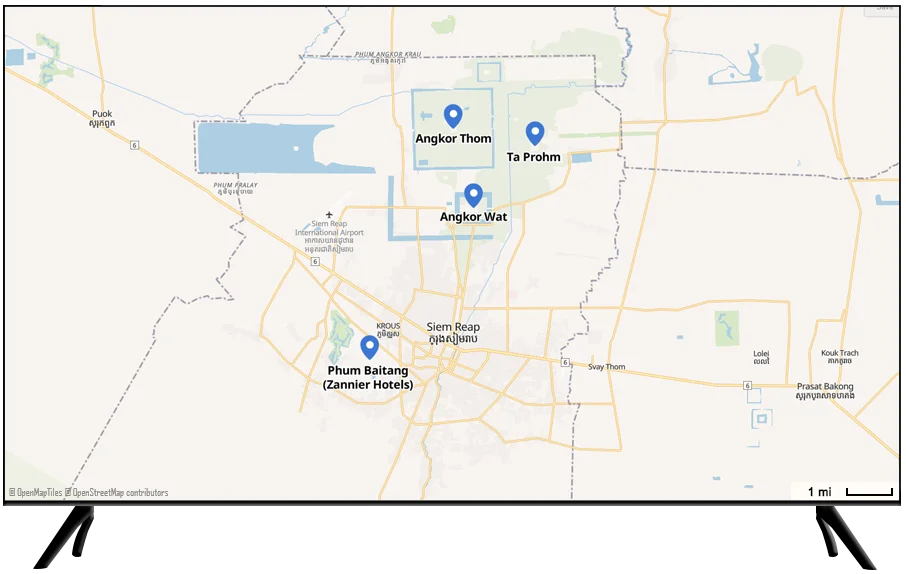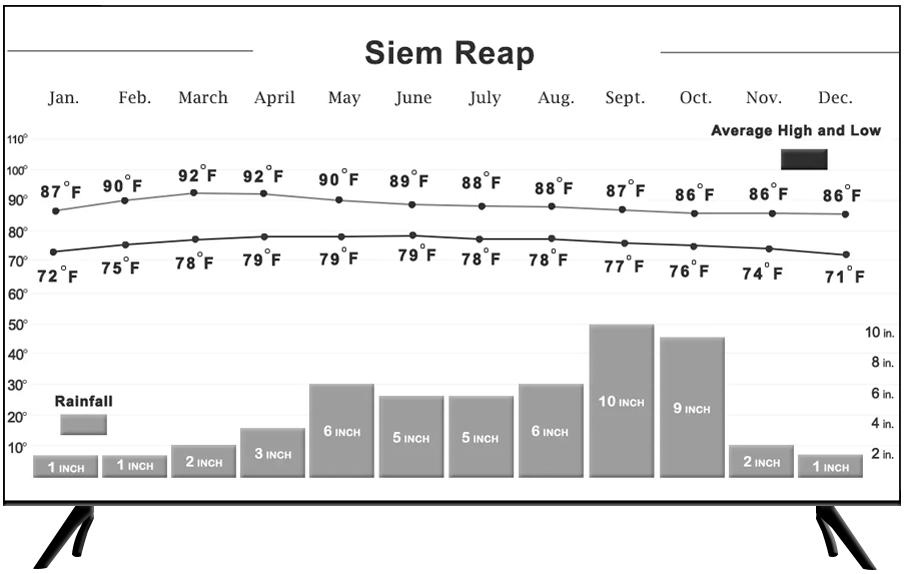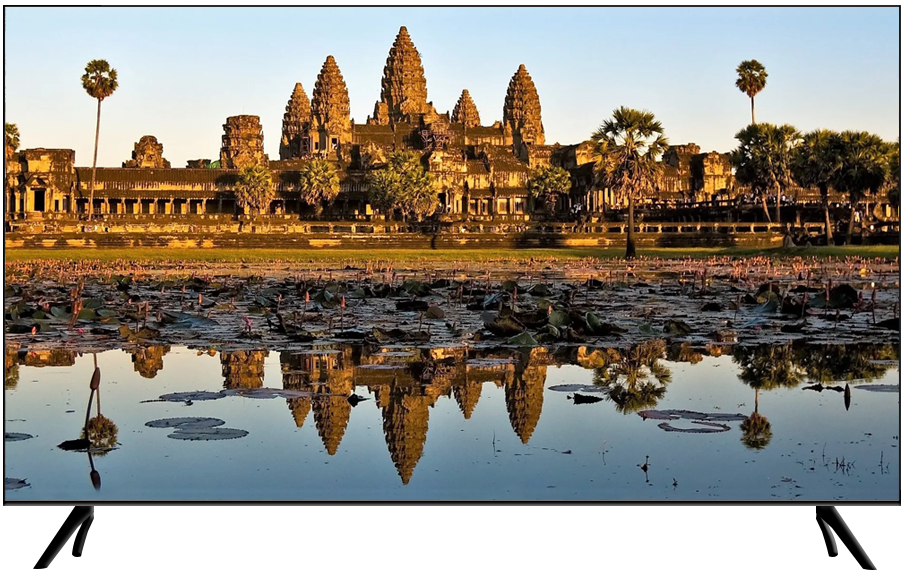


Day 12. Siem Reap
Overnight – Bensley Collection Shinta Mani
Rising well before dawn, proceed for your exploration of the most famous temple in Southeast Asia, Angkor Wat. Believed to be the world’s largest religious building, this 12th century temple is a perfect fusion of symbolism and symmetry and a source of pride and strength to all Khmers. Arrive at the monuments entrance before the sun rises and walk to a location near the temple, where your sunrise view of Angkor Wat is across lotus ponds. This is the best time to visit Angkor Wat because it is the least crowded during the early morning, and watching the sunrise over the awe-inspiring complex is an experience not to be missed. After admiring the sunrise, you will proceed into the massive complex to discover its incredible structures and plethora of intricacies, which will be highlighted by your Tour Director.
After exploring Angkor Wat you are driven back to your resort for some time to freshen up and to have breakfast. In the late morning you will explore the immense walled city of Angkor Thom and its multiple awe-inspiring monuments built at a scale that is simply amazing. Following the occupation of Angkor by the Chams from 1177 to 1181, the king decided to build an impregnable fortress at the heart of his empire.
The causeway is lined by an intricate bridge depicting the Churning of the Ocean of Milk from Hindu mythology in which the Devas (gods) and Asuras (devils) are engaged in tug of war with a Naga (seven-headed serpent) to obtain the elixir of immortality. Begin your visit at the Terrace of the Leper King. This intricately carved platform was the royal crematorium and the statue that was originally thought to be the leper king is now believed to be Yama, the god of death.
You will continue along the Terrace of Elephants, originally used as a viewing gallery for the king to preside over parades, performances, and sporting events. At the southern end lies the Baphuon, once of the most beautiful temples at Angkor, dating from the 11th century. It has undergone a massive renovation by the French and is now once again open for viewing. Next up is the enigmatic and enchanting temple of the Bayon. At the exact center of Angkor Thom, this is an eccentric expression of the creative genius and inflated ego of Cambodia’s most celebrated king. Its 54 towers are each topped off with the four faces of Avalokiteshvara (Buddha of Compassion), all of which bear more than a passing resemblance to the king himself.
There is a break for lunch after which you will visit mystical Ta Prohm, which has been abandoned to the elements. Left as it was discovered by French explorer Henri Mouhout in 1860, the tentacle-like tree roots here are slowly strangling the surviving stones. This was one of the settings for the original Tomb Raider movie. Complete your exploration of this section of Angkor’s wealth of monuments with a visit to another temple that makes you feel like you have traveled back in time – Preah Khan. This large temple has also been left unrestored for the most part and is a fascinating maze of narrow passageways and windows that each offers their own unique view into the past.
Rising well before dawn, proceed for your exploration of the most famous temple in Southeast Asia, Angkor Wat. Believed to be the world’s largest religious building, this 12th century temple is a perfect fusion of symbolism and symmetry and a source of pride and strength to all Khmers. Arrive at the monuments entrance before the sun rises and walk to a location near the temple, where your sunrise view of Angkor Wat is across lotus ponds. This is the best time to visit Angkor Wat because it is the least crowded during the early morning, and watching the sunrise over the awe-inspiring complex is an experience not to be missed. After admiring the sunrise, you will proceed into the massive complex to discover its incredible structures and plethora of intricacies, which will be highlighted by your Tour Director.
After exploring Angkor Wat you are driven back to your resort for some time to freshen up and to have breakfast. In the late morning you will explore the immense walled city of Angkor Thom and its multiple awe-inspiring monuments built at a scale that is simply amazing. Following the occupation of Angkor by the Chams from 1177 to 1181, the king decided to build an impregnable fortress at the heart of his empire.
The causeway is lined by an intricate bridge depicting the Churning of the Ocean of Milk from Hindu mythology in which the Devas (gods) and Asuras (devils) are engaged in tug of war with a Naga (seven-headed serpent) to obtain the elixir of immortality. Begin your visit at the Terrace of the Leper King. This intricately carved platform was the royal crematorium and the statue that was originally thought to be the leper king is now believed to be Yama, the god of death.
You will continue along the Terrace of Elephants, originally used as a viewing gallery for the king to preside over parades, performances, and sporting events. At the southern end lies the Baphuon, once of the most beautiful temples at Angkor, dating from the 11th century. It has undergone a massive renovation by the French and is now once again open for viewing. Next up is the enigmatic and enchanting temple of the Bayon. At the exact center of Angkor Thom, this is an eccentric expression of the creative genius and inflated ego of Cambodia’s most celebrated king. Its 54 towers are each topped off with the four faces of Avalokiteshvara (Buddha of Compassion), all of which bear more than a passing resemblance to the king himself.
There is a break for lunch after which you will visit mystical Ta Prohm, which has been abandoned to the elements. Left as it was discovered by French explorer Henri Mouhout in 1860, the tentacle-like tree roots here are slowly strangling the surviving stones. This was one of the settings for the original Tomb Raider movie. Complete your exploration of this section of Angkor’s wealth of monuments with a visit to another temple that makes you feel like you have traveled back in time – Preah Khan. This large temple has also been left unrestored for the most part and is a fascinating maze of narrow passageways and windows that each offers their own unique view into the past.

